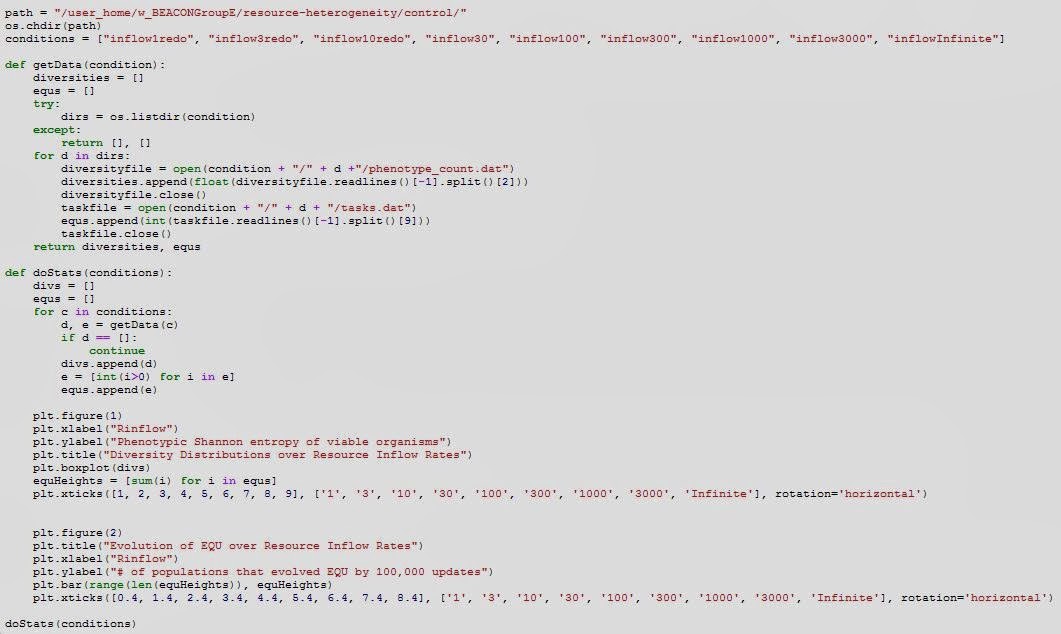We've been working on the extension phase of our project, implementing resource heterogeneity. We've decide to implement resource heterogeneity spatially, by adding patches of resources associated with each task into defined areas in the world. We will be increasing or decreasing the sizes of the patches, thus changing the amount resources overlap. Isolated, small sized patches will lead to complete spatial heterogeneity, while large, completely overlapping patches will lead to complete spatial homogeneity.
 |
| Figure 1. Abstract diagram of spatial resource heterogeneity. Each colored circle represents a patch in the world where a given resource is available at a high inflow rate. The panel on the left represents, where the patches barely overlap, represents high spatial heterogeneity. The panel on the right, where patches overlap more and up to four resources are available in a given place in the world, represents lower spatial heterogeneity. |
We will be investigating how spatial heterogeneity affects phenotypic diversity. We believe that competition for resources drives diversity, and that by limiting the resources to certain areas in the world, we will be creating niches for different types of organisms to thrive in. As such, we predict similar results to Walker and Ofria (2012), in that intermediate levels of spatial heterogeneity will lead to maximum phenotypic diversity. When resources are completely heterogeneous (i.e. resources are not found in the world in conjunction with any other resources), there will be too much competition and struggle just to survive, so new phenotypes will not arise. On the other end of the spectrum, when resources are completely homogeneous (i.e. all resources are found in conjunction with every other resource), there will be no pressure to specialize in a certain set of tasks, so only generalists will thrive, leading to reduced diversity as well.
We will also be investigating how spatial heterogeneity affects the evolvability of complex tasks, specifically, the EQU task in Avida. We predict that this evolvability with peak at intermediate spatial heterogeneity as well; however, it may be possible that evolvability follows a more linear trend with spatial heterogeneity, because as resources become more homogenously distributed, there will be more of the "building block" simpler task resources available to use to do the complex EQU task.
To implement spatial heterogeneity in Avida, we are using gradient resources. Each resource is associated with one of the nine computational tasks, Not, Nand, And, Xor, OrNot, Nor, Or, AndNot, Equals
Our resources world in avida is shown below:
 |
| Figure something. Spatial resource heterogeneity. |
Isnt it cool. How'd we do that? We wrote a python script to randomly place each resource in two of the given patches. Here's that script below:

 |
| Figure something. Python script to randomly place resources in two patches in the world. |
We are using the index of Shannon entropy of the resources in the world as a way to quantify spatial heterogeneity. To change the Shannon entropy of the resources, and thus the spatial heterogeneity, we are increasing or decreasing the radius of the patches. Here's how we predict radius to affect entropy.
Figure of entropy vs radius.
 |
| Figure. Entropy vs patch radius. |
Why? because uncertainty decreases with increasing radius until new niche is formed. Figure of heterogeneous patches to homogeneous patches.
 |
| Figure something. How overlap effects entropy. |
So what have we successfully done so far? We have done, with non-depletable resources, radius 6,8,10,15,20,24,36,48,59. IE all along the entropy vs radius spectrum. Heres what we are finding, as we predicted.
 |
| Figure something. Entropy treatments (in terms of patch radius size). Top phenotypic diversity, bottom, evolve equals by update 100,000. |
Next step? To make these resources depleteable within a patch. We believe this will increase competition and may lead to more diversity. Starting with inflow 100 across these different patch radii, may change the inflow rates around to see how effects.






